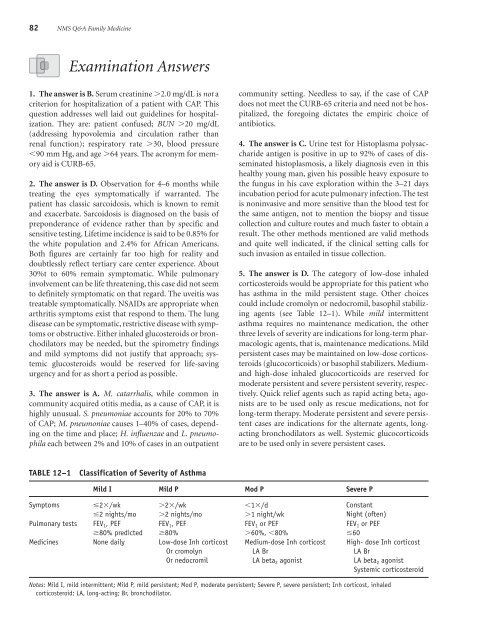NMS Q&A Family Medicine
NMS Q&A Family Medicine
NMS Q&A Family Medicine
- No tags were found...
You also want an ePaper? Increase the reach of your titles
YUMPU automatically turns print PDFs into web optimized ePapers that Google loves.
82 <strong>NMS</strong> Q&A <strong>Family</strong> <strong>Medicine</strong>Examination Answers1. The answer is B. Serum creatinine 2.0 mg/dL is not acriterion for hospitalization of a patient with CAP. Thisquestion addresses well laid out guidelines for hospitalization.They are: patient confused; BUN 20 mg/dL(addressing hypovolemia and circulation rather thanrenal function); respiratory rate 30, blood pressure 90 mm Hg, and age 64 years. The acronym for memoryaid is CURB-65.2. The answer is D. Observation for 4–6 months whiletreating the eyes symptomatically if warranted. Thepatient has classic sarcoidosis, which is known to remitand exacerbate. Sarcoidosis is diagnosed on the basis ofpreponderance of evidence rather than by specific andsensitive testing. Lifetime incidence is said to be 0.85% forthe white population and 2.4% for African Americans.Both figures are certainly far too high for reality anddoubtlessly reflect tertiary care center experience. About30%t to 60% remain symptomatic. While pulmonaryinvolvement can be life threatening, this case did not seemto definitely symptomatic on that regard. The uveitis wastreatable symptomatically. NSAIDs are appropriate whenarthritis symptoms exist that respond to them. The lungdisease can be symptomatic, restrictive disease with symptomsor obstructive. Either inhaled glucosteroids or bronchodilatorsmay be needed, but the spirometry findingsand mild symptoms did not justify that approach; systemicglucosteroids would be reserved for life-savingurgency and for as short a period as possible.3. The answer is A. M. catarrhalis , while common incommunity acquired otitis media, as a cause of CAP, it ishighly unusual. S. pneumoniae accounts for 20% to 70%of CAP; M. pneumoniae causes 1–40% of cases, dependingon the time and place; H. influenzae and L. pneumophilaeach between 2% and 10% of cases in an outpatientcommunity setting. Needless to say, if the case of CAPdoes not meet the CURB-65 criteria and need not be hospitalized,the foregoing dictates the empiric choice ofantibiotics.4. The answer is C. Urine test for Histoplasma polysaccharideantigen is positive in up to 92% of cases of disseminatedhistoplasmosis, a likely diagnosis even in thishealthy young man, given his possible heavy exposure tothe fungus in his cave exploration within the 3–21 daysincubation period for acute pulmonary infection. The testis noninvasive and more sensitive than the blood test forthe same antigen, not to mention the biopsy and tissuecollection and culture routes and much faster to obtain aresult. The other methods mentioned are valid methodsand quite well indicated, if the clinical setting calls forsuch invasion as entailed in tissue collection.5. The answer is D. The category of low-dose inhaledcorticosteroids would be appropriate for this patient whohas asthma in the mild persistent stage. Other choicescould include cromolyn or nedocromil, basophil stabilizingagents (see Table 12–1 ). While mild intermittentasthma requires no maintenance medication, the otherthree levels of severity are indications for long-term pharmacologicagents, that is, maintenance medications. Mildpersistent cases may be maintained on low-dose corticosteroids(glucocorticoids) or basophil stabilizers. Mediumandhigh-dose inhaled glucocorticoids are reserved formoderate persistent and severe persistent severity, respectively.Quick relief agents such as rapid acting beta 2 agonistsare to be used only as rescue medications, not forlong-term therapy. Moderate persistent and severe persistentcases are indications for the alternate agents, longactingbronchodilators as well. Systemic glucocorticoidsare to be used only in severe persistent cases.TABLE 12–1 Classification of Severity of AsthmaMild I Mild P Mod P Severe PSymptoms 2 /wk 2 nights/mo2 /wk2 nights/moPulmonary tests FEV 1 , PEFFEV 1 , PEF 80% predicted 80%<strong>Medicine</strong>s None daily Low-dose Inh corticostOr cromolynOr nedocromil 1 /d1 night/wkFEV 1 or PEF60%, 80%Medium-dose Inh corticostLA BrLA beta 2 agonistConstantNight (often)FEV 1 or PEF 60High- dose Inh corticostLA BrLA beta 2 agonistSystemic corticosteroidNotes: Mild I, mild intermittent; Mild P, mild persistent; Mod P, moderate persistent; Severe P, severe persistent; Inh corticost, inhaledcorticosteroid; LA, long-acting; Br, bronchodilator.
















